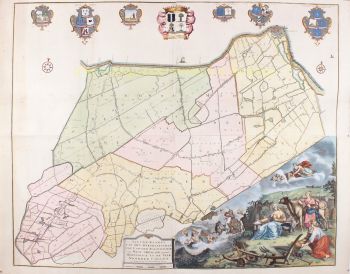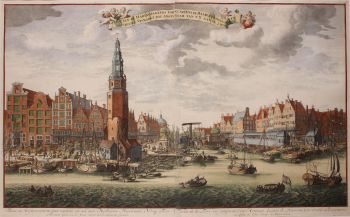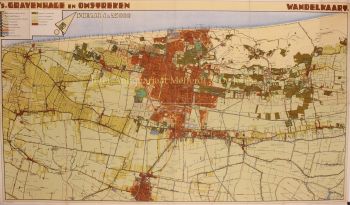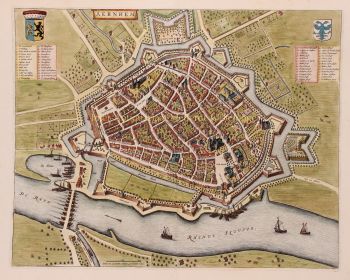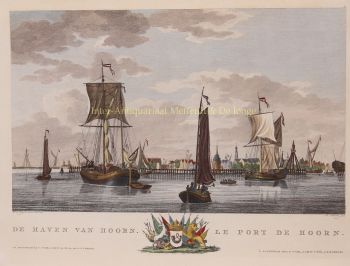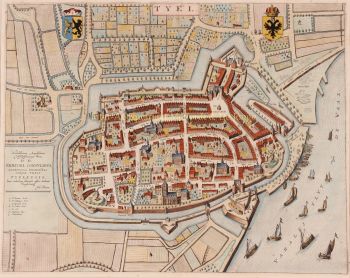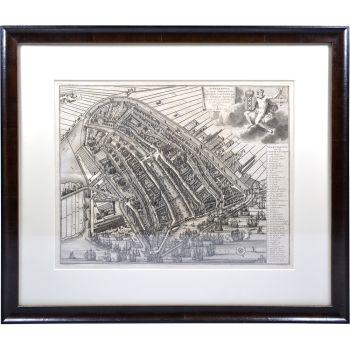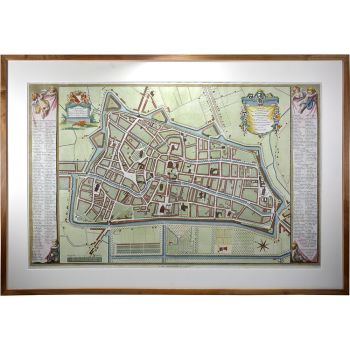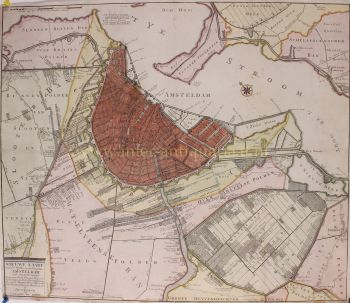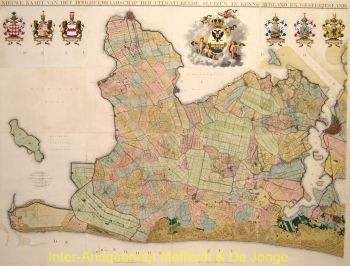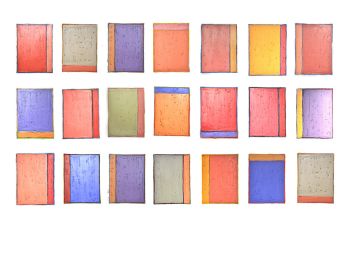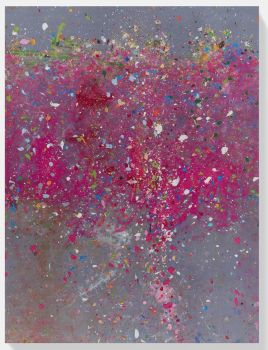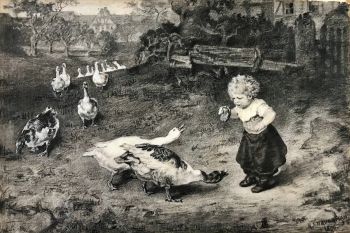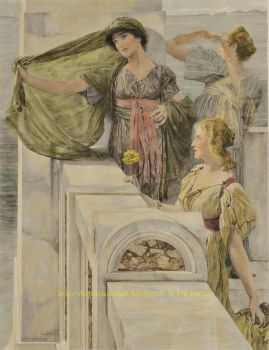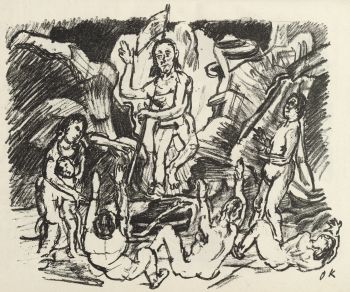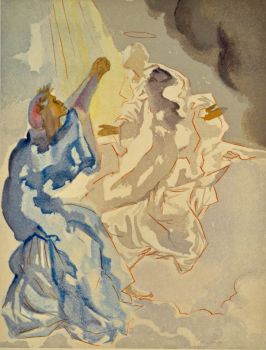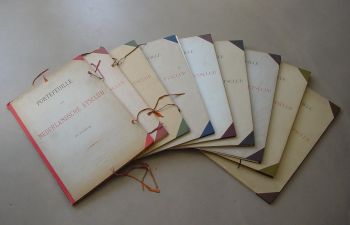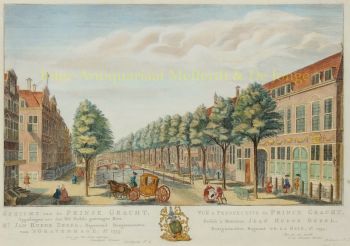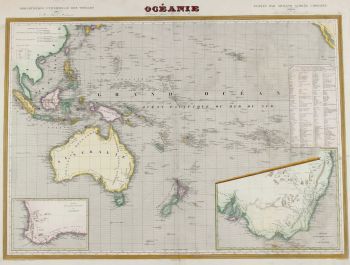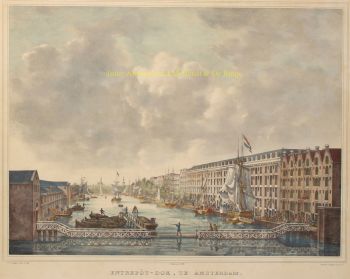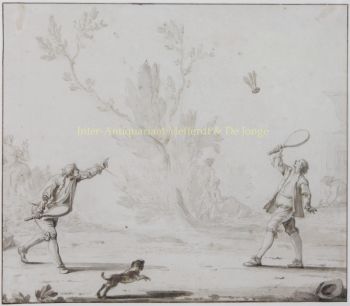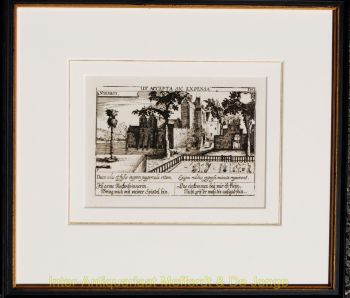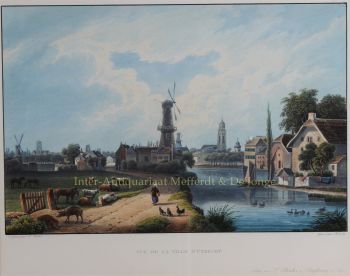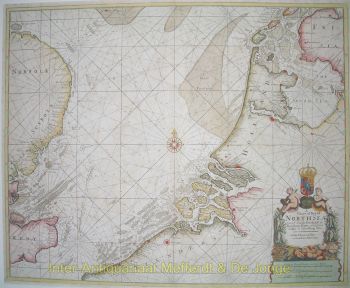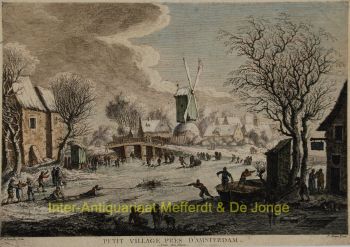Amsterdam 1783
Hendrik Leth
€ 2.250
Inter-Antiquariaat Mefferdt & De Jonge
- Sur l'oeuvre d'art
PLAN TRES EXACT DE LA VILLE FAMEUSE MARCHANDE D'AMSTERDAM. Copper engraving printed on two sheets by Hendrik de Leth, published 1783. Measures 57.5 x 88 cm. On 24 and 27 April 1734, the following advertisement appeared in the Amsterdamsche Courant: "Te Amsterd. By Hend. De Leth on the Beurssluys, is now published, an entirely new and accurate Plan of the city of Amsterdam, with many additions that were not found in any previous plans; decorated on both sides with the coats of arms of the Wel-Ed. en Groot Agtb. Heeren Burgemeesteren deezer stad, zedert de Reformatie tot nu, door voorname Liefhebbers keurig nagezien". One could choose between a rich version with family coats of arms and the coats of arms of the Amsterdam mayors on both sides, and a plain version without the coats of arms. This copy is the version without the coats of arms. Hendrik de Leth had made a reliable map amidst many competitors (such as Covens & Mortier), which was very useful in the city administration. The dignified French title seems destined for a more representative function, but for the rest the print is entirely in Dutch, which was convenient for the artisans and administrative users. Under the title we read "Gravée et mis au jour Par Henry de Leth a l'enseigne du Pecheur". This can be translated as "Engraved and updated to the present day by Hendrik de Leth under the label of Visser." The shop of publisher Nicolaes Visscher II kept this name, even after his death in 1702. Hendrik de Leth and also his father Andries worked in Visscher's shop when he was still alive. After Visscher's death his widow Elisabeth Verseyl continued the business until 1726. From about 1720, however, the daily management was in the hands of Andries. After he took over the business, he maintained the shop's well-known name. After his death in 1731, Hendrik, the son of Andries, took over. He too continued with the same shop name. The map is extremely clear and uncluttered, with only the main buildings standing out. Hendrik de Leth made the map after an older example and provided it with completely new decoration. An interesting difference between the map by De Leth and the earlier one is that De Leth gave the buildings engraved in the uprising a shadow. The sunlight here comes from the left, which corresponds to the eastern morning sun. To the left of the decorative, opening curtain, we see a Caarte van Amstelland. It is striking that in the legend block in the top right-hand corner, an I is mentioned after nine buildings. The legend explains this with the words NB Daar een I bystaat betekent Jansenisten. Jansenism, named after Cornelis Jansenius (1585-1638), was a religious and political movement from the seventeenth and eighteenth centuries that developed mainly in France as a reaction to certain developments in the Catholic Church and to the absolutism of the rulers of those days. The Jansenists' way of life was characterised by their ascetic rejection of the world and their pessimistic ethics. They also rejected, among other things, papal infallibility. The accentuation of the buildings on the map that had a relationship with Jansenism suggests that the engraver and publisher Hendrik de Leth adhered to this political movement. The central representation under the map is designed with care and taste. The title plate is beautifully incorporated into a group of figures, in which the city virgin is flanked by the two lions of the city arms and the river gods of Amstel and IJ, while Fortuna rises from the sea. The compass rose and ruler, like the title, have been given a three-dimensional shape as part of this grouping. The city seal and coat of arms above the map are carried by two angels. Literature: Marc Hameleers - Maps of Amsterdam 1538-1865, nr. 114 p.228-231 Price: Euro 2.250
- Sur l'artiste
Hendrik de Leth (Amsterdam, 31 mai 1703 - Amsterdam, 17 juin 1766) était un graveur, aquafortiste, graveur, cartographe, dessinateur, libraire, marchand d'art, éditeur d'estampes, collectionneur d'art et collectionneur de naturalia.
Hendrik de Leth était le fils d'Andries de Leth (coupeur d'assiettes, libraire, 1662-1731) et de Nelletje Middenheespen. Hendrik avait un frère aîné, Christiaan de Leth. En 1742, Hendrik épousa Sophia Otto, décédée en 1753. Leur mariage resta sans enfant. Il était probable que le neveu Andries, fils du frère de Hendrik, Christiaan, deviendrait le successeur de l'entreprise de Hendrik. Cependant, il mourut en 1743. En 1766, Hendrik de Leth fit rédiger un testament juste avant sa mort, par lequel Catharina le Blanc, petite-fille du frère Christiaan, devint héritière. Le 30 septembre 1766, la vente aux enchères de son domaine eut lieu.[3]
En 1728, Hendrik rejoint la guilde des libraires. Auparavant, il était l'élève de son père Andries de Leth, qui avait repris la concession de cartes, d'estampes et d'art 'Op de Beurssluys, in den Visscher' à Amsterdam du cartographe et graveur Nicolaas Visscher II. Hendrik de Leth reprend à son tour cette entreprise après la mort de son père en 1731.
Dès 1725, l'œuvre Images de la ville Wijdtvermaarde d'Amsterdam a été publiée en plus de ses bâtiments et gesites les plus importants, tous dessinés avec précision après la vie et publiés à Amsterdam.
Son ouvrage le plus connu avec 100 gravures a été publié en 1730 : La splendeur de la bénédiction Kennemerlant : montre de nombreux visages glorieux des lieux de plaisir les plus importants de ce dernier, des maisons nobles, des bâtiments de village et de ville : à commencer par Kastrikum (...) / dessiné après la vie et dans le cuivre apporté par H. de Leth ; et brièvement décrit par M. Brouërius van Nidek. - Amsterdam : De Leth, 1730. De nombreuses estampes d'Amsterdam réalisées par De Leth se trouvent dans les archives de la ville d'Amsterdam.
En tant que cartographe, De Leth était surtout connu pour son Nouvel Atlas géographique et Atlas historique, Van de Zeven Vereenigde Nederlandsche Provintien, publié en 1740. De Leth s'est également fait connaître pour les gravures sur cuivre qu'il a réalisées vers 1758 de la carte générale de la colonie ou province du Suriname d'après le dessin d' Alexandre de Lavaux .
Êtes-vous intéressé par l'achat de cette oeuvre?
Artwork details
Related artworks
- 1 - 4 / 24
- 1 - 4 / 12


